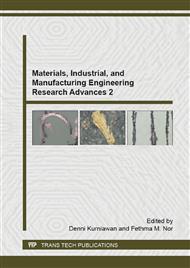p.317
p.322
p.327
p.332
p.337
p.345
p.350
p.355
p.360
Microwave Assisted Pyrolysis of Rice Husk in the Presence of Eco Friendly Microwave Absorber in Producing Bio-Oil
Abstract:
Rice husk is one of the major agriculture waste that has high potential as carbon and energy source and does not been utilized well. The potential was in producing bio oil and pyrolysis is one method that has been established for the purpose. In this research, the pyrolysis of rice husk by using microwave irradiation as the heating source in the existence of microwave absorber char was investigated. The effect of three operating variables, namely microwave power (Watt), reaction time (min) and the amount of microwave absorber (g) were studied. From the study, The highest bio-oil yield were produced about 40.75% at microwave power of 600 W, 20 min reaction time, and 3.5 g amount of microwave absorber with consistent flow of 4 L/min of nitrogen gas. The bio-oil produced were analyzed using gas chromatography and was found contains important chemical compounds such as phenols, ketone, aldehyde and carboxylic acids.
Info:
Periodical:
Pages:
337-341
Citation:
Online since:
October 2015
Keywords:
Price:
Сopyright:
© 2015 Trans Tech Publications Ltd. All Rights Reserved
Share:
Citation:


